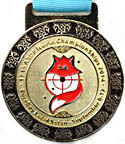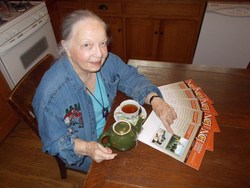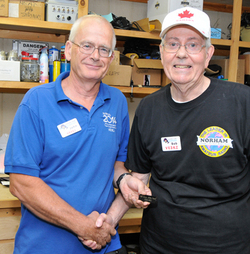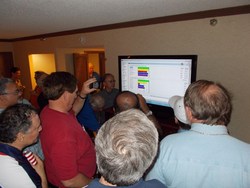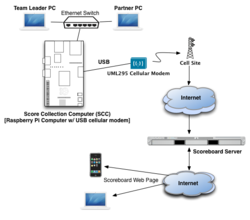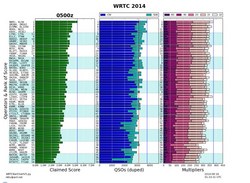 September 24, 2014 Editor: Ward Silver, NØAX | |||||||
IN THIS ISSUE
NEW HF OPERATORS - THINGS TO DO State your preference! Two of the "bigs" in the State QSO Party lineup - California and Texas - are coming up. And so are Maine and New Jersey, for that matter. State contests are especially good for starting contesters and those with modest stations and antenna farms. Digital mode fans will want to join the excitement in the CQ WW RTTY contest, too! BULLETINS There are no bulletins in this issue. BUSTED QSOS CQ WW RTTY Director, Ed WØYK clarifies a report in the previous issue about certificates: "The new Cabrillo tag is only about mailed paper certificates. Anybody can download their certificate at any time from the CQ WW websites (both CW/SSB and RTTY)." Ed also notes that certificates for past contests are readily available at all times for them to access. CONTEST SUMMARY Complete information for all contests follows the Conversation section September 27-28
October 4-5
From counties with millions in population to the deserted desert desserts, the California QSO Party has managed to wrangle activations of all 58 counties again this year! No mean feat, there will be mobiles and portable stations galore to track down in search of that elusive bottle of wine or other awards. The complete list is available under the "County Operating Plan". (Thanks, CQP Manager, Chris N6WM)
The U.S. team brought home a silver medal at the recent Amateur Radio Direction Finding World Championships - all the way from first-time host country, Kazakhstan! The competition attracted 277 competitors from 25 countries around the world. The events included sprints (with actual sprinting!) and a hybrid event called foxoring that combines traditional orienteering and foxhunting. The CQ World Wide Committee announced that translations for the CQ WW DX Contest rules are now available in 14 languages. (Thanks, CQ WW Director, Randy K5ZD) There is a very nice survey of available SDR equipment in the September issue of the Dutch Kingdom Amateur Radio Society's DKARS Magazine. This architecture is spreading quite rapidly across ham radio - you'll have to watch carefully so as not to miss something! That big radio you have your eye on, is it too big for the shack? Or at least too big to sneak into the shack? How about this ant-sized radio designed for the IoT (Internet of Things - not IOTA)? You'll have no problem finding a spot for it. Finding it in the first place, though, might be a problem. (Thanks, Dennis N6KI) A recent online discussion about Sweepstakes wondered about the history of power categories in this oldest of the domestic contests. Mike K1MK did a great job to put together this concise timeline: 1930 - In the beginning there were no power classes. 1934 - For the fifth running of Sweepstakes, power multipliers for scoring are introduced with three classes: <= 25 watts input x 3; > 20 watts input; <= 75 watts input x 2; and 75 watts input x1. 1935 - Power mults simplified to <= 100w input x 1.5. 1938 - The "power factor" (multiplier) is reduced to x 1.25 and the dividing line remains 100 watts input. 1952 - The multiplier is increased to x 1.5 for Phone, CW is still x 1.25, and 100 watts is the limit for both modes. 1956 - The low power limit is increased to 150 watts input for both modes. 1968 - Precedence of A or B is introduced based upon the 150 watt input limit for the low power class (A). 1969 - The power multiplier for scoring is eliminated. 1972 - The low power class is increased to 200 watts input. 1974 - Separate awards issued to the highest scoring category "A" and "B" entrants in each section. Prior to this, it was one award per section to the highest score regardless of class. 1983 - Definition of low power category changed to 150 watts output.
On Sept. 12th, student scientists in California launched a weather balloon to the stratosphere during the most intense solar storm of the year. They expected to measure an increase in energetic radiation. Instead they measured a sharp drop. Their counterintuitive data and the interesting explanation for it are featured on the Spaceweather website. JK Antennas' high performance antennas are now available exclusively from DX Engineering. JK Antennas' flagship product is the JK404 Grande, a 40 meter Yagi antenna that offers up to 6.16 dBd (8.31 dBi) gain with a 1.5:1 SWR (or better) across the entire 40 meter band. The antenna uses four full-size elements (73 foot maximum element length), mounted on a 45.5 foot boom. It weighs 325 pounds with a maximum turning radius of 43 feet. Despite the JK404 Grande's large size, it only has an 18.7 square foot wind area. The JK65 is a similarly high-achieving antenna for the 6 meter band with only 1.37 square feet of wind load and a weight of 14 pounds. How did that Pirate QSO Party turn out? Captain San W6RRR reports, "The Pirate QSO Party went very well! It was great to see how creative people got with their exchanges, although I think the "Walk the Plank" command was under-utilized. More than 120 participants were logged, representing 9 DXCC entities (United States, Hawaii, Puerto Rico, Canada, Mexico, Japan, Brazil, Trinidad, and the Dominican Republic). The Java-based logging program was pretty experimental but generally well-received, and 15 logs have been submitted so far. Also, two hours was just long enough for all of us to find our sea legs -- prepare for a somewhat longer contest in 2015!" Part 7 and Part 8 of the NCJ antenna interaction articles by K3NA are now available at the NCJ web site in the Bonus Content area. (Thanks, NCJ Editor Emeritus, Kirk K4RO)
Web Site of the Week - Some news stories have reported on a new technique of "twisting" radio beams to increase wireless data rates. 32 gigabits per second is pretty fast! The Slashdot website's discussion sheds some light on the subject, with various comments explaining why this is different than the circular polarization familiar to many hams using VHF+ bands. By creating beams with different and varying angular phases, several beams with the same frequency can share the same path, yet still be distinguished at the receiver as if they came from different directions. We should give that a try during Phone Sweepstakes! WORD TO THE WISE A fall is a common reason for a trip to the Emergency Room for older adults, usually male, when they look up, feel faint, then pass out when working on a ladder or on a tower. The usual cause is restricting blood flow in the arteries at the base of the brain when tipping one's head back. It seems to be a condition that becomes more pronounced with age. You can test this fairly easily: stand straight and tall - then tip your head back as far as it will go without bending your back. A few seconds of readjustment before you get your equilibrium back is more or less normal. If dizziness persists or gets worse, you have a problem to have checked out by your doctor. It is better to find this out at ground level than aloft, don't you think? A master photo gallery has been created on the WRTC2014 website. There is an album for each of the 59 operating sites/teams. More photos are always welcome, particularly of the W1I team (W2RE and WW2DX). Contact Randy K5ZD for information. Thanks to N6TV and EY8MM for providing many of the photos. Albums of the opening and closing ceremonies will soon be available as well. What did we miss at the Maker Faire? This EDN blog talks about the creative and imaginative engineering fostered by the Faires. ARRL Contest Branch Manager, Matt W1MSW continues to post new and updated content to the ARRL's Contest Results web page. Downloadable CSV files are now all up to date and all Log Checking Reports (LCRs) are now posted, as well. There are a few nits yet to fix in past writeups and the log handling machinery needs constant attention but the backlog in the results is now a thing of the past. If you participated in the ARRL's September VHF+ Contest, be sure to check the Logs Received page and verify your entry is noted with the right category, location, and call sign. OPERATING TIP Speaking of LCRs, also known as UBN (Unique-Busted-NIL) reports, now is a great time to start looking over your errors from last year. Think of it as watching game video from the previous game - it will alert you to your weaknesses and help you focus on improving what needs to be improved! Tuning an impedance matching network like an L network to match a feed point impedance is fairly straightforward. But what about for an antenna that you use on two bands? You could switch between different component values, such as by using a different tap on an inductor or adding a capacitor. Switching in coaxial stubs also works, but Doug W7KF found an alternative solution that he put to work on his Inverted L for 160 and 80 meters. The original idea came from an 1970s QST article by Wes Hayward W7ZOI ("Hints and Kinks" in the June 1977 issue) that lets the network switch itself in and out by using resonance. As Wes observes, while having the antenna be resonant on the lower band simplifies adjustment considerably, in the general case, the antenna doesn't need to be resonant on either band.
Pasternak has a new online package of RF calculator and conversion tools developed by its engineering staff. Here are a few of the many interesting tools of interest to hams: balanced attenuator calculator, cascaded noise figure calculator, coaxial cable impedance calculator, RF power conversion calculator, RF power ratio conversion calculator, VSWR/return loss calculator and more. Broadcast engineers will find some just for them, as well! Each calculator includes diagrams and illustrations along with the formula in use. (Thanks, Eric W3DQ) We have the CW Skimmer keeping an ear on the bands for us, do you think you can do better? If so, the Morse Learning Machine Challenge is for you! No word has been received as to whether the final evaluation will be done during CW Sweepstakes. There are quite a few low-cost online PC board fabricators that will deliver several boards in a batch but this can be expensive if you only need a couple of boards made. There's another approach called a PC-board aggregator. These services combine your small order with the small orders of others and makes a composite board that is then sliced up and sent to the customers. You must submit a board design prepared with a layout package that generates Gerber files and pay a certain amount per square inch of board area. One such aggregator is OSH Park which charges $5.00 per square inch for double-sided boards with a silkscreen. (Thanks, Brad AA1IP) There is a good collection of downloadable white papers on grounding and lightning protection from the Polyphaser company at the Smiths Power website. The list includes a paper specifically on grounding amateur stations. (Thanks, Bill KC4PE) If you use rope running through a pulley to hold up a wire antennas, it's important to move or shift the rope from time-to-time. Leaving the pull rope "setting" in one spot for extended periods of time causes excess wear, as the outer fibers are elongated/stretched more than the inner ones. Just a little movement 2-3 times per year will go a long way toward keeping that rope flexible and doing its job. (Thanks, Don K4ZA) While we may consider stainless steel to be the best of the best materials, it can corrode when deprived of oxygen and needs to be inspected like everything else. Sailors know corrosion as well as anyone and this Cruising World article describes the problem and how to check for corrosion. (Thanks, Kirby AF6OP) Several useful gadgets and projects showed up recently on the Instructables website. The creator of this Instructable on straightening and stripping wire mentions the possible uses as "Antenna Construction". Too bad he didn't build a pipe and tower stretcher says Frank KR1ZAN! This razor blade cutter functions as a nifty mini-shear for wire and plastic - watch your fingers! And another builder made use of a switchmode dc-to-dc converter module to create a bench-style power supply. It runs with 7-35 volts input power and outputs 1.25-30 volts at up to 3 amps depending on the heat sink. The project also demonstrates how to create an etched front panel. As the fall semester kicks into gear, you may have a STEM-oriented student in the family or know of one. This EE Times slide show features 10 technological elements, one of which is sure to hold the interest of your student. Some are intended for the school environment and some for individuals at home learning on their own. Technical Web Site of the Week - Physics fans will be thrilled to learn that the famed Feynman Lectures have all been released free online. Covering a wide variety of topics, you can learn from a master physicist whose work garnered a Nobel Prize and inspired generations of students. Watching a Submarine Race I've written at times about visualization being an important component that is currently missing from much of radiosport. We like numbers - particularly final scores - and don't seem too concerned about the process by which those numbers were obtained. And why should we be? No one watches us as we sit in front of the radios and computers in our basement or bedroom redoubts. The door is shut and the household tiptoes around for the weekend whispering, "There's a contest on!" Finally, we emerge: a little bleary, somewhat the worse for wear and tear, with our far-away eyes still somewhere out there in the ionosphere. After we get a little sleep and shape-shift back into human form, friends and family will inquire, "How was it? Did you win?" And so we recount the battles won and lost, the highs and lows, and whether we beat the cross-town rivals or came up short. Don't you think those folks might want to watch a little bit? Maybe just to check the scores from time to time even if the exact operating technique is a bit opaque? Certainly other hams would be interested, but except for contests that include QSO serial number as part of the exchange, it's all invisible. Watching a typical radiosport contest is like watching a submarine race. You know they're out there...somewhere...and you know they're focused and intense and working hard...somehow...but you can't see a thing. Nor will you learn anything about the race until the "fish" surface, one by one, to tell their tales.
That might be about to change, at least for radiosport. We've had a real-time scoreboard or two for a while now. More stations are uploading scores and even breakdowns, so it is starting to happen. During the WRTC2014 a new gadget came into play - a network "sniffer" that watched for QSOs being "broadcast" in a digital stream, grabbed the information, and submitted it to the central scoreboard server. Inexpensive and based on a Raspberry Pi computer, the sniffer (aka - the Score Collection Computer) required no modification to the host software, just access to the stream of contact data as each QSO was logged by the competitors. This is not very far from live QSO validation and scoring, although that would require considerably more computing resources, such as are available in the "cloud". In the meantime, couldn't we be seeing a lot more information and visuals of the competition? For an idea of what is possible even at this early stage, Bob N6TV has created some "after the fact" horse-race-style graphics in the style of Chuck NO5W's PileUpNet software so popular at the Dayton CW Pileup Contest sponsored by the Kansas City DX Club.
Until we finally get real-time radiosport, I am hoping that some of the creative programmers out there are thinking about what they could do with access to a stream of QSO data from hundreds or thousands of competitors all logging contacts as fast as they can. What sort of combinations of views makes sense? Will it be something like ESPN's GameCast system - a collection of maps and charts and statistics that capture the competitive state of the game? In the meantime this fall, as 0000 UTC approaches, be sure to dog your hatches, lower the periscope, sound the klaxon and Dive! Dive! The submarine race is about to begin! 24 September through 7 October An expanded, downloadable version of QST's Contest Corral in PDF format is available. Check the sponsor's Web site for information on operating time restrictions and other instructions. HF CONTESTS SKCC Straight Key Sprint--CW, from Sep 24, 0000Z to Sep 24, 0200Z. Bands (MHz): 1.8-28, 50, Monthly on the 4th Wednesday UTC. Exchange: RST, QTH, name, SKCC nr or power. Logs due: 5 days. Rules CQ WW RTTY Contest--Digital, from Sep 27, 0000Z to Sep 28, 2359Z. Bands (MHz): 3.5-28. Exchange: RST, CQ zone and State/VE area (US/VE). Logs due: 5 days. Rules Maine QSO Party--Phone,CW, from Sep 27, 1200Z to Sep 28, 1200Z. Bands (MHz): 1.8-28. Exchange: RS(T), county or "DX". Logs due: Oct 15. Rules Texas QSO Party--Phone,CW,Digital, from Sep 27, 1400Z - See website. Multiple time periods. Bands (MHz): 1.8-28, 50,144, CW--20 to 50 kHz above band edge; Phone--25 kHz above edge of General segment. Exchange: RS(T), county or S/P/C. Logs due: Oct 31. Rules Peanut Power Sprint--Phone,CW, from Sep 28, 2000Z to Sep 28, 2200Z. Bands (MHz): 7-21. CW--7.061, 14.061, 21.061; SSB--7.285, 14.285, 21.285. Exchange: RST, S/P/C, and Peanut nr or power. Logs due: Oct 15. Rules 222 MHz Fall VHF Sprint--Phone,CW,Digital, from Sep 30, 7 PM to Sep 30, 11 PM. Bands (MHz): 222. Exchange: 4-char grid square. Logs due: 2 weeks. Rules CWOps Weekly Mini-CWT Tests--CW, from Oct 1, 1300Z - See website. Multiple time periods. Bands (MHz): 1.8-28. Weekly on Wednesday, 28 to 38 kHz above band edge. Exchange: Name and member number or S/P/C. Logs due: 2 days. Rules NS Weekly Sprint--CW, from Oct 3, 0230Z to Oct 3, 0300Z. Bands (MHz): 1.8-14. Weekly on Thursday evenings local time. Exchange: Serial, name, and S/P/C. Logs due: 2 days. Rules DX/NA YLRL Anniversary Party--Phone,CW,Digital, from Oct 3, 1400Z to Oct 5, 0200Z. Bands (MHz): 1.8-28. Exchange: Serial, RS(T), and S/P/C. Logs due: 30 days. Rules TARA PSK Rumble--Digital, from Oct 4, 0000Z to Oct 4, 2400Z. Bands (MHz): 1.8-28, 50. Exchange: Name and call area (see website). Logs due: Oct 31. Rules Oceania DX Phone Contest--Phone, from Oct 4, 0800Z to Oct 5, 0800Z. Bands (MHz): 1.8-28. Exchange: RS and serial. Logs due: Oct 31. Rules Russian WW Digital Contest--Digital, from Oct 4, 1200Z to Oct 5, 1159Z. Bands (MHz): 1.8-28. Exchange: RST and 2-char oblast code or serial. Logs due: 5 days. Rules Worked All Britain HF Contest--Phone, from Oct 4, 1200Z to Oct 5, 1200Z. Bands (MHz): 14-28. Exchange: RS, serial, DXCC entity or WAB area. Logs due: Oct 28. Rules New Jersey QSO Party--Phone,CW, from Oct 4, 1600Z - See website. Multiple time periods. Bands (MHz): 3.5-28, 144. Exchange: RS(T) and NJ county or S/P or "DX". Logs due: Oct 25. Rules California QSO Party--Phone,CW, from Oct 4, 1600Z to Oct 5, 2200Z. Bands (MHz): 1.8-28, 50,144. Exchange: Serial and state/prov/"DX" or CA county. Logs due: Oct 31. Rules RSGB 21/28 MHz Contest--Phone,CW, from Oct 5, 0700Z to Oct 5, 1900Z. Bands (MHz): 21,28. Exchange: Serial and UK district. Logs due: 16 days. Rules EU Autumn Phone Sprint--Phone, from Oct 6, 1600Z to Oct 6, 1959Z. Bands (MHz): 3.5-14. Exchange: Both call signs, serial, name. Logs due: 15 days. Rules OK1WC Memorial Contest--Phone,CW, from Oct 6, 1630Z to Oct 6, 1730Z. Bands (MHz): 3.5, 7. Weekly on Monday, see website for bands. Exchange: RS(T) and serial. Logs due: 5 days. Rules ARS Spartan Sprint--CW, from Oct 7, 0200Z to Oct 7, 0400Z. Bands (MHz): 3.5-28. Monthly on the first Monday evening local time. Exchange: RST, S/P/C, and power. Logs due: 2 days. Rules VHF+ CONTESTS SKCC Straight Key Sprint--CW, from Sep 24, 0000Z to Sep 24, 0200Z. Bands (MHz): 1.8-28, 50, Monthly on the 4th Wednesday UTC. Exchange: RST, QTH, name, SKCC nr or power. Logs due: 5 days. Rules Texas QSO Party--Phone,CW,Digital, from Sep 27, 1400Z - See website. Multiple time periods. Bands (MHz): 1.8-28, 50,144, CW--20 to 50 kHz above band edge; Phone--25 kHz above edge of General segment. Exchange: RS(T), county or S/P/C. Logs due: Oct 31. Rules 222 MHz Fall VHF Sprint--Phone,CW,Digital, from Sep 30, 7 PM to Sep 30, 11 PM. Bands (MHz): 222. Exchange: 4-char grid square. Logs due: 2 weeks. Rules TARA PSK Rumble--Digital, from Oct 4, 0000Z to Oct 4, 2400Z. Bands (MHz): 1.8-28, 50. Exchange: Name and call area (see website). Logs due: Oct 31. Rules New Jersey QSO Party--Phone,CW, from Oct 4, 1600Z - See website. Multiple time periods. Bands (MHz): 3.5-28, 144. Exchange: RS(T) and NJ county or S/P or "DX". Logs due: Oct 25. Rules California QSO Party--Phone,CW, from Oct 4, 1600Z to Oct 5, 2200Z. Bands (MHz): 1.8-28, 50,144. Exchange: Serial and state/prov/"DX" or CA county. Logs due: Oct 31. Rules LOG DUE DATES 24 September through 7 October
ARRL Information Click here to advertise in this newsletter, space subject to availability. Your One-Stop Resource for Amateur Radio News and Information ARRL membership includes QST, Amateur Radio's most popular and informative journal, delivered to your mailbox each month. Subscribe to NCJ - the National Contest Journal. Published bimonthly, features articles by top contesters, letters, hints, statistics, scores, NA Sprint and QSO Parties. Subscribe to QEX - A Forum for Communications Experimenters. Published bimonthly, features technical articles, construction projects, columns and other items of interest to radio amateurs and communications professionals. Free of charge to ARRL members: Subscribe to The ARRL Letter (weekly digest of news and information), the ARES E-Letter (monthly public service and emergency communications news), Division and Section news -- and much more! ARRL offers a wide array of products to enhance your enjoyment of Amateur Radio. Visit the site often for new publications, specials and sales. Donate to the fund of your choice -- support programs not funded by member dues! Reprint permission can be obtained by sending email to permission@arrl.org with a description of the material and the reprint publication. ACKNOWLEDGEMENTS ARRL Contest Update wishes to acknowledge information from WA7BNM's Contest Calendar and SM3CER's Contest Calendar. | |||||||
